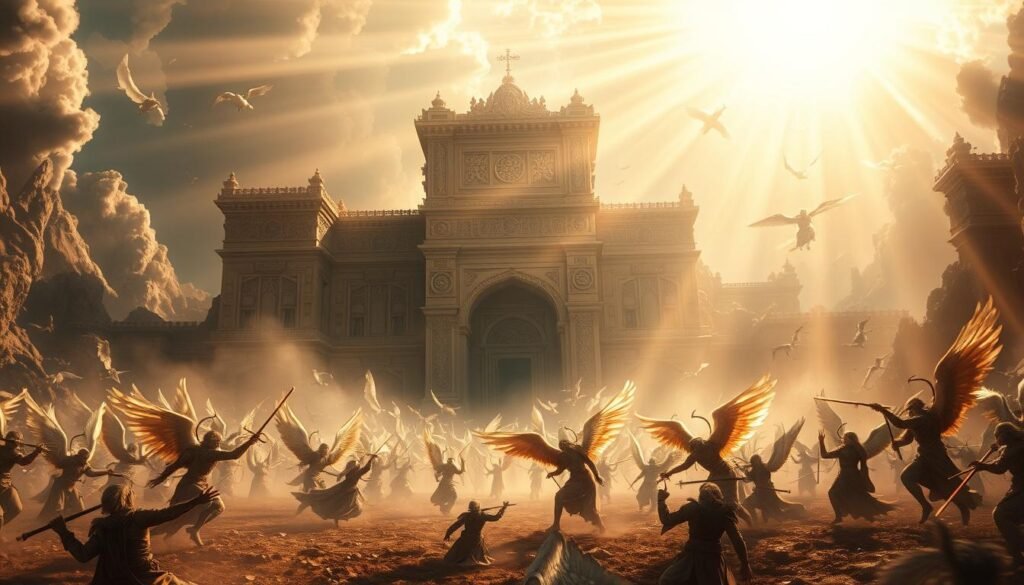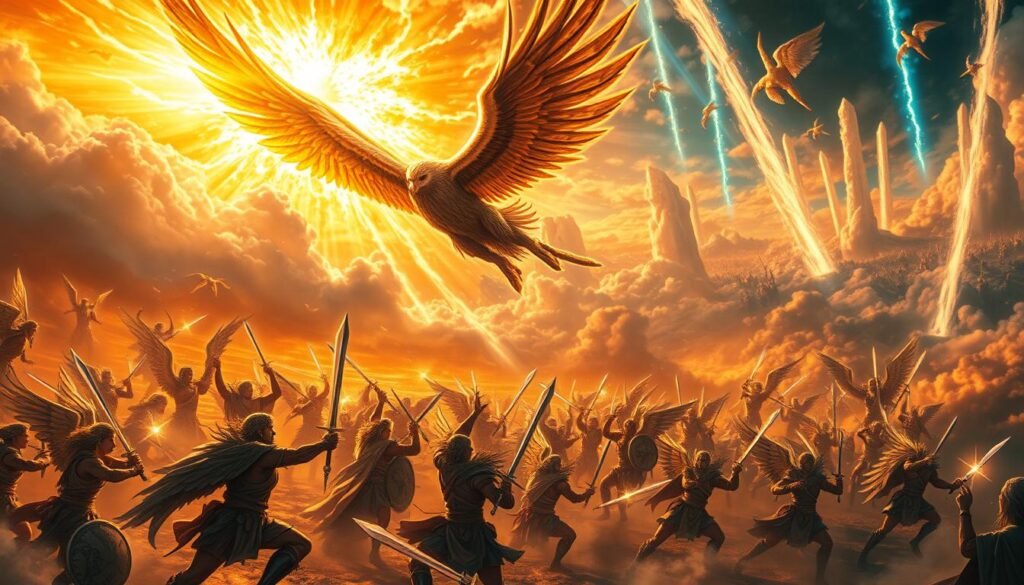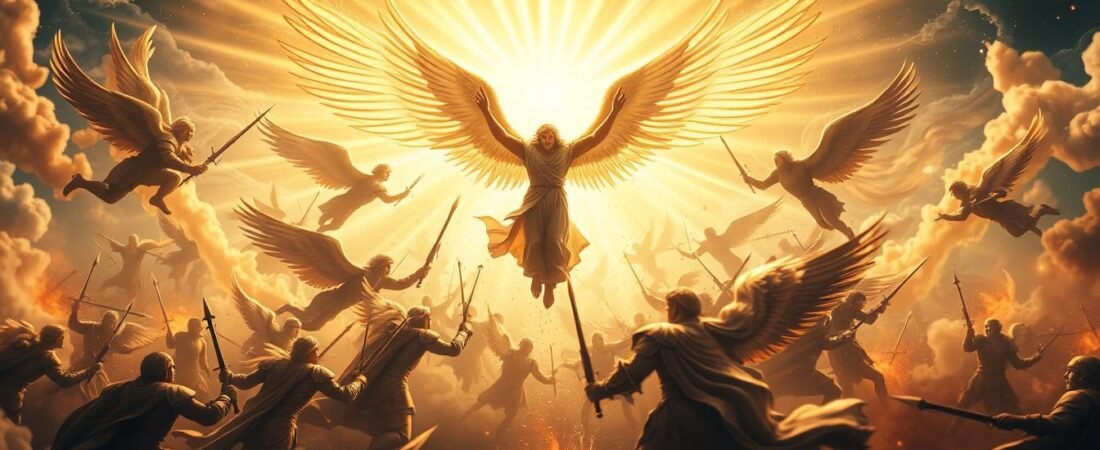The concept of a war in heaven is a topic of significant theological debate, rooted in biblical interpretations. The biblical account in Revelation 12:7-9 describes a conflict between Michael and his angels against the dragon (Satan) and his angels.
This event is often linked to Isaiah 14 and Ezekiel 28, which are interpreted as describing the fall of Lucifer. The question remains whether this conflict was indeed the first war.
Key Takeaways
- The biblical account of a war in heaven is primarily found in Revelation 12:7-9.
- Isaiah 14 and Ezekiel 28 are also key scriptures related to the fall of Lucifer.
- The interpretation of these scriptures varies among theologians.
- The concept of a war in heaven sparks significant theological debate.
- Understanding the biblical context is crucial to unraveling the truth.
The Cosmic Battlefield: Understanding Spiritual Warfare
Understanding the cosmic battlefield requires exploring the biblical framework and ancient Near Eastern concepts of heavenly conflict. The biblical narrative presents a complex interplay between divine and human realms, where spiritual beings engage in conflict that influences human history.
Ancient Near Eastern Concepts of Heavenly Conflict
In ancient Near Eastern cultures, the concept of heavenly conflict was prevalent, often involving gods and goddesses in battles that determined the fate of humanity. These mythological narratives influenced the biblical account, which adapted and transformed these concepts to fit its theological framework.
The Biblical Framework for Spiritual Realms
The Bible introduces a spiritual realm where angels, demons, and other heavenly beings operate. This realm is not just a backdrop for human activity but an active participant in the cosmic narrative.
Visible vs. Invisible Realities in Scripture
Scripture distinguishes between visible and invisible realities. The visible world is what we experience through our senses, while the invisible realm includes spiritual beings and forces that shape our reality.
| Realm | Characteristics | Biblical Reference |
|---|---|---|
| Visible | Physical, tangible | Genesis 1:1-31 |
| Invisible | Spiritual, intangible | Ephesians 6:12 |
By understanding these concepts, we gain insight into the nature of spiritual warfare and the heavenly conflict that underpins human experience.
Lucifer’s Rebellion: The First Act of Cosmic Insurrection
Lucifer’s uprising marked the inception of the first war in heaven, a conflict that would have far-reaching consequences. This event is pivotal in understanding the nature of spiritual warfare and the dynamics between divine authority and angelic rebellion.
The Original Position of Lucifer in Heaven
Lucifer, once a prominent figure in heaven, held a significant position among the angelic hierarchy. His role was crucial in the celestial order, and his actions had profound implications.
His Role Among the Angelic Hierarchy
As a high-ranking angel, Lucifer’s responsibilities likely included worship, service, and possibly even governance within the heavenly realm. His original position underscores the magnitude of his subsequent rebellion.
The Nature of His Transgression
The biblical account suggests that pride was the root of Lucifer’s transgression, leading to a desire to usurp God’s authority. This pride manifested as ambition, driving Lucifer to challenge the established divine order.
Pride as the Root of Celestial Conflict
Pride, in this context, is not merely a personal failing but a fundamental challenge to divine sovereignty. It led to a cosmic insurrection that would forever alter the heavenly landscape.
The story of Lucifer’s rebellion, as linked to Isaiah 14 and Ezekiel 28, provides a framework for understanding the origins of cosmic conflict. It highlights the dangers of unchecked ambition and the importance of humility in the celestial hierarchy.
Isaiah 14: Decoding the Fall of the Morning Star
The prophecy in Isaiah 14 offers a profound insight into the fall of Lucifer, often referred to as the Morning Star. This passage is crucial for understanding the biblical narrative surrounding the origin of evil.
Historical Context of Isaiah’s Prophecy
Isaiah’s prophecy was delivered during a time of great turmoil in Judah, with the Assyrian threat looming large. However, the prophecy against the king of Babylon in Isaiah 14:4-21 is often interpreted as having a dual fulfillment, with the fall of Lucifer being a significant aspect.
The Five “I Wills” of Lucifer’s Ambition
Lucifer’s ambition is outlined through five “I wills” in Isaiah 14:13-14, demonstrating his desire to usurp God’s authority. These statements reveal a deep-seated pride and rebellious spirit.
- “I will ascend to heaven”
- “I will raise my throne above the stars of God”
- “I will sit enthroned on the mount of assembly”
- “I will ascend above the tops of the clouds”
- “I will make myself like the Most High”
Theological Implications of Attempted Usurpation
The attempt by Lucifer to usurp God’s authority has significant theological implications. It highlights the dangers of pride and the nature of sin.
| Aspect | Description | Theological Implication |
|---|---|---|
| Pride | Lucifer’s pride led to his downfall | The danger of pride is a recurring theme in scripture |
| Rebellion | The five “I wills” demonstrate Lucifer’s rebellious spirit | Rebellion against God is a fundamental aspect of sin |
| Usurpation | Lucifer’s attempt to usurp God’s authority | Highlights the futility of challenging God’s sovereignty |
Understanding the fall of the Morning Star through the lens of Isaiah 14 provides valuable insights into the truth hidden within scripture, revealing the complexities of spiritual conflict.
Ezekiel 28: The Perfect Cherub Corrupted
The prophecy against the king of Tyre in Ezekiel 28 offers a profound insight into the corruption of a once-perfect being. This chapter is often interpreted as having a dual fulfillment, addressing both the earthly king of Tyre and a heavenly being.
The Lamentation Over the King of Tyre
Ezekiel 28 begins with a lamentation over the king of Tyre, describing his pride and corruption. The passage highlights the king’s wisdom and beauty, stating that he was in Eden, the garden of God (Ezekiel 28:13).
Dual Fulfillment in Earthly and Heavenly Realms
The prophecy is believed to have a dual fulfillment, applying to both the historical king of Tyre and a spiritual being, often interpreted as Lucifer or Satan. This dual fulfillment is a common theme in biblical prophecy, where earthly events serve as precursors to greater spiritual realities.
Eden Imagery and Pre-Adamic Existence
The use of Eden imagery in Ezekiel 28:13 is significant, as it connects the king of Tyre to the biblical account of creation and the fall. The passage implies a pre-Adamic existence, suggesting that the being described had a role or presence before the creation of humanity.
| Key Imagery | Symbolic Meaning |
|---|---|
| Eden, the garden of God | Paradise or divine presence |
| Precious stones | Beauty and value |
| Cherub | Guarding or protective role |
Revelation 12: John’s Vision of the Primordial Conflict
Revelation 12 presents a pivotal moment in the biblical narrative, describing the first war in heaven and its key protagonists. This chapter is crucial for understanding the nature of spiritual warfare and the origins of the conflict between good and evil.
The Woman, Child, and Dragon Symbolism
The passage describes a vision given to John, involving a woman clothed with the sun, a male child, and a great red dragon. The woman is often interpreted as Israel or the church, the child represents Jesus Christ, and the dragon symbolizes Satan. This symbolism highlights the spiritual dimensions of the conflict.
Michael’s Leadership in Heavenly Battle
The text also describes a war in heaven, where Michael and his angels fought against the dragon and his followers. Michael’s leadership in this battle underscores his significant role in the spiritual warfare narrative.
The Timing of Satan’s Expulsion from Heaven
The timing of Satan’s expulsion from heaven is a topic of debate among scholars. Some interpret it as occurring before the creation of the world, while others see it as happening after Jesus’ ascension. Understanding the timing is crucial for interpreting the broader biblical narrative.
| Interpretation | Description | Timing |
|---|---|---|
| Pre-Creation | Satan’s fall occurred before the world was created. | Before Genesis 1:1 |
| Post-Ascension | Satan’s expulsion happened after Jesus’ ascension. | After Acts 1:9 |
Did the First War Begin in Heaven? The Truth Hidden in Scripture!
Delving into the scriptures reveals clues about the first war and its possible beginning in heaven. The biblical narrative provides a rich tapestry of events that have been interpreted in various ways throughout history.
Chronological Evidence in Biblical Narratives
The Bible offers several accounts that can help us understand the timing of the first war. By examining these narratives, we can piece together a chronological framework.
Pre-Creation vs. Post-Creation Theories
Scholars have proposed different theories regarding the timing of the first war. Some argue it occurred before creation, while others believe it happened after the world was formed. Understanding these theories is crucial to interpreting the biblical account.

Scriptural Clues About the Original Conflict
The scriptures contain numerous references to the original conflict, providing valuable insights into its nature and consequences. By synthesizing these clues, we can gain a deeper understanding of the events that unfolded.
Synthesizing Old and New Testament References
Both the Old and New Testaments offer perspectives on the first war. For instance, the book of Isaiah and the book of Revelation contain passages that shed light on the conflict. By combining these references, we can form a more comprehensive picture of what occurred.
The truth hidden in scripture is slowly revealed as we carefully examine the biblical narratives and their interpretations. This exploration not only deepens our understanding of the first war but also its relevance to our lives today.
The Great Division: Angels Who Remained Faithful vs. Those Who Fell
Scripture reveals a significant split among heavenly beings during the primordial conflict. This division marked a crucial turning point in the history of the universe, shaping the course of spiritual warfare.
The Two-Thirds Who Stayed Loyal
The faithful angels, constituting two-thirds of the heavenly host, remained loyal to God. Their steadfastness is a testament to their commitment to divine authority.
Their Continued Ministry to God and Humanity
These loyal angels continue to serve God and humanity, acting as messengers and agents of divine will. Their ministry is a source of comfort and strength for believers.
The One-Third Who Followed Satan
Conversely, one-third of the angels rebelled against God, following Satan in his insurrection. This drastic decision had profound consequences for their nature and role in the universe.
Their Transformation into Demonic Forces
The fallen angels, now known as demonic forces, seek to oppose God’s plans and harm humanity. Understanding their origin and purpose is crucial for navigating the complexities of spiritual conflict.
| Characteristics | Faithful Angels | Fallen Angels |
|---|---|---|
| Loyalty | Remained loyal to God | Followed Satan |
| Role | Minister to God and humanity | Oppose God, harm humanity |
| Nature | Retain heavenly nature | Transformed into demonic forces |
Michael the Archangel: Heaven’s Chief Warrior
Michael the Archangel is a pivotal character in the biblical narrative, embodying the essence of heavenly warfare. As the chief warrior of heaven, Michael’s role is multifaceted, involving protection, leadership, and divine justice.
Biblical Appearances and Significance
Michael appears in several key biblical contexts, most notably in the books of Daniel, Jude, and Revelation. His appearances are often associated with significant events in the history of God’s people.
Daniel’s Prophecies and Michael’s Role
In Daniel 10:13 and 12:1, Michael is described as a “chief prince” who stands guard over Israel. His role is that of a protector and a leader in the spiritual battles that unfold in the heavenly realms.
The Contrast Between Michael and Lucifer
The contrast between Michael and Lucifer is stark. While Lucifer represents rebellion and chaos, Michael embodies order and divine authority. This contrast is highlighted in Jude 1:9, where Michael disputes with Satan over Moses’ body, demonstrating a reverence for God’s authority that is absent in Lucifer’s actions.
| Characteristics | Michael | Lucifer |
|---|---|---|
| Role | Chief Warrior/Protector | Rebel/Deceiver |
| Authority | Submissive to God’s will | Seeks to usurp God’s authority |
Eden’s Invasion: The Heavenly War Extends to Earth
The heavenly war’s impact on earth is vividly illustrated in the narrative of Eden’s invasion. This pivotal event marks the transition of the cosmic conflict from the heavenly realm to the earthly domain, directly affecting humanity.

The Serpent’s Strategy in Genesis 3
The serpent’s appearance in Genesis 3 signifies the beginning of a new phase in the heavenly war, where the conflict is brought to humanity. The serpent’s strategy involves deception and manipulation, aiming to disrupt the relationship between God and humanity.
Continuing the Rebellion Through Human Agents
The serpent’s actions in Eden demonstrate an attempt to continue the rebellion against God by involving human agents. This strategy is crucial in understanding the nature of spiritual warfare, as it highlights the role of human beings in the larger cosmic conflict.
Humanity Caught in Crossfire of Spiritual Conflict
Humanity becomes unwittingly entangled in the spiritual conflict between the forces of good and evil. This entanglement is not merely a passive condition; it involves active participation in the conflict through choices and actions that either align with or against God’s will.
| Aspect | Pre-Invasion Eden | Post-Invasion Eden |
|---|---|---|
| Human Relationship with God | Direct, unmediated | Altered by deception |
| Nature of Human Existence | Peaceful, obedient | Conflicted, disobedient |
| Role of the Serpent | Absent | Deceiver, manipulator |
Understanding Eden’s invasion provides insights into the broader context of spiritual warfare as described in scripture. It highlights the complexities of human existence caught between divine will and malevolent forces.
Denominational Perspectives on Heavenly Warfare
Different Christian traditions offer unique perspectives on the nature and implications of heavenly warfare. This diversity of thought reflects the complex and multifaceted nature of the biblical narrative regarding spiritual conflict.
Catholic and Orthodox Traditions
Catholic and Orthodox traditions place a significant emphasis on the role of angels and saints in heavenly warfare. They believe in the intercession of saints and the importance of angels in spiritual battles. For instance, the Catholic Church venerates St. Michael the Archangel, who is considered a powerful warrior against evil.
Protestant and Evangelical Interpretations
Protestant and Evangelical interpretations tend to focus on the authority of Scripture and the role of faith in spiritual warfare. They often emphasize the believer’s direct relationship with God and the power of prayer in overcoming spiritual challenges.
Dispensationalist Views on Angelic Conflict
Dispensationalists have a distinct view on angelic conflict, often seeing it as part of a larger dispensational framework that includes various periods or dispensations in God’s dealings with humanity. They typically emphasize the role of angels in these different dispensations and the ongoing struggle between good and evil.
The varied perspectives on heavenly warfare highlight the richness and complexity of Christian thought on this topic. Understanding these different views can enrich one’s appreciation of the spiritual dimensions of Christian theology.
Living Amidst Ongoing Spiritual Warfare
Understanding the ongoing spiritual warfare is crucial for navigating our everyday challenges. As believers, we are not just passive observers; we are active participants in a cosmic conflict that has been unfolding since the beginning of time.
Recognizing the Battle in Everyday Life
The spiritual battle is not just a distant reality; it affects our daily lives in profound ways. From the temptations we face to the spiritual growth we experience, everything is influenced by this ongoing conflict.
Ephesians 6 and the Armor of God
The Apostle Paul’s letter to the Ephesians provides crucial guidance on how to stand firm in this battle. The “Armor of God” described in Ephesians 6 is not just metaphorical; it represents the spiritual defenses we need to protect ourselves against the enemy’s attacks.
“Put on the whole armor of God, that you may be able to stand against the schemes of the devil.” – Ephesians 6:11
This armor includes truth, righteousness, the gospel of peace, faith, salvation, and the word of God. Each piece is vital for withstanding the spiritual assaults we face.
The Church’s Strategic Position in Cosmic Conflict
The church is not just a gathering of believers; it is a strategic outpost in the cosmic conflict. As the body of Christ, we have a pivotal role to play in the unfolding drama of redemption.
| Aspect | Role in Cosmic Conflict |
|---|---|
| Prayer | Engaging in spiritual warfare through intercession |
| Worship | Declaring victory and honor to God |
| Community | Providing support and strength to believers |
By understanding our position and equipping ourselves with the armor of God, we can effectively live amidst the ongoing spiritual warfare, standing firm in our faith and advancing the kingdom of God.
Conclusion: The Final Victory and Restoration of Heavenly Peace
The biblical narrative ultimately looks forward to a final victory and the restoration of heavenly peace, rooted in divine revelation and the promise of a new heaven and a new earth.
This ultimate triumph is a testament to the power of divine revelation, which has guided humanity through the complexities of the heavenly conflict. As we reflect on the cosmic battle between good and evil, we are reminded of the hope and promise that lies at the heart of the biblical narrative.
The restoration of heavenly peace is not just a future aspiration but a present reality for those who live in accordance with divine revelation. By understanding the heavenly conflict and its implications, believers can navigate the challenges of spiritual warfare with confidence and faith.
In this context, the promise of a new heaven and a new earth serves as a powerful reminder of God’s sovereignty and love, ultimately bringing an end to the heavenly conflict and ushering in an era of eternal peace.

